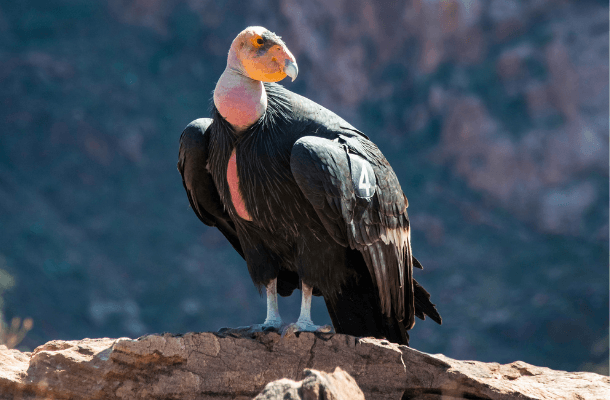Review Begins for Permitting Incidental Take of California Condors at Wind Energy Facility
Media Contact: Jordan Rutter, Director of Public Relations, 202-888-7472 | jerutter@abcbirds.org | @JERutter
Expert Contact: Joel Merriman, Bird-Smart Wind Energy Campaign Director | jmerriman@abcbirds.org

California Condors are federally Endangered and one of the country's greatest conservation success stories. They are also increasingly likely to come into conflict with wind energy facilities. Photo by Georgi Baird
(Washington, DC, December 22, 2020) The U.S. Fish and Wildlife Service is now accepting public comments on the expected unintentional killing (or “incidental take”), under the Endangered Species Act, of California Condors at an existing wind energy facility. As the species has recovered from near-extinction, its range has continued to expand, bringing the birds more and more frequently into areas where wind turbines have been constructed.
“Condor recovery is a huge conservation success story, so we need to take wind turbine collision risk very seriously,” said Joel Merriman, Director of the Bird-Smart Wind Energy Campaign at American Bird Conservancy. “Losing even one of these magnificent birds is too many. We commend the facility operator for stepping up and working with the Fish and Wildlife Service to identify the means to avoid killing condors."
“This is just one of several existing wind energy facilities in this area,” Merriman added. “It's hard not to conclude that we have already taken too great a risk with one or our rarest and most iconic birds.”
By the late 1980s the population of the California Condor was just over 20 birds. Thanks to decades of focused conservation efforts, the U.S. Fish and Wildlife Service now places the population at more than 400 individuals. “This species' recovery is a testament to a huge amount of effort by stakeholders and the strength of the Endangered Species Act,” said Merriman. “But we absolutely cannot take this recovery for granted. We must ensure that we avoid this kind of conflict now and moving forward.”
“Smart wind energy planning starts with selecting an appropriate location, where risks to birds are minimized,” said Merriman. “This is especially true for species like California Condors, which have too many other threats to contend with and a slow rate of reproduction. We urge everyone involved to be more stringent about where wind energy facilities are allowed to be built in this species' range moving forward. We will be there every step of the way to ensure that the appropriate lessons are learned.”
ABC thanks the Leon Levy Foundation for its support of ABC's Bird-Smart Wind Energy Campaign.
###
American Bird Conservancy is a nonprofit organization dedicated to conserving birds and their habitats throughout the Americas. With an emphasis on achieving results and working in partnership, we take on the greatest problems facing birds today, innovating and building on rapid advancements in science to halt extinctions, protect habitats, eliminate threats, and build capacity for bird conservation. Find us on abcbirds.org, Facebook, Instagram, and Twitter (@ABCbirds).


















































